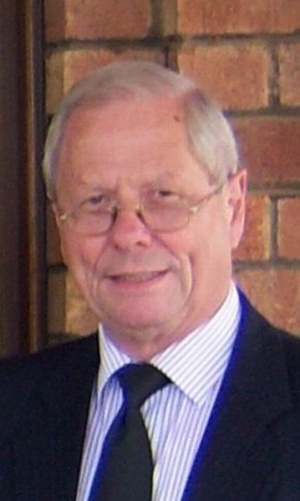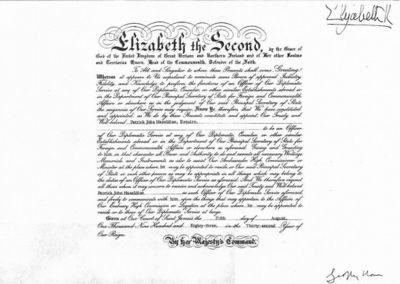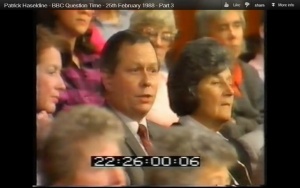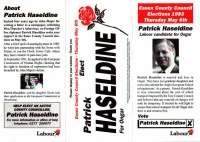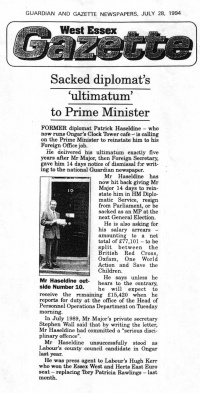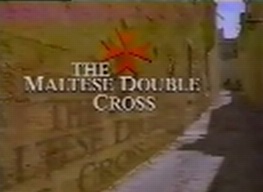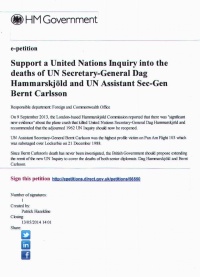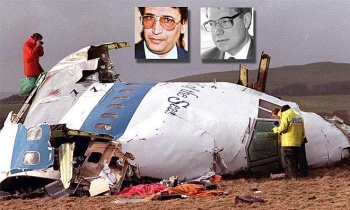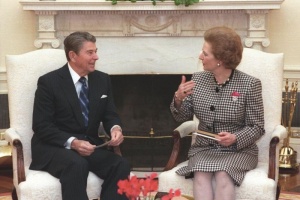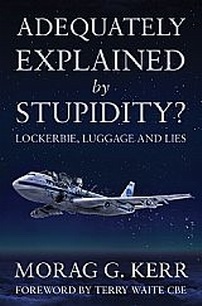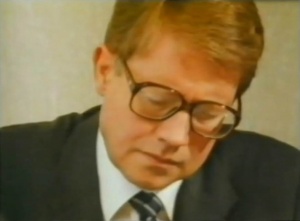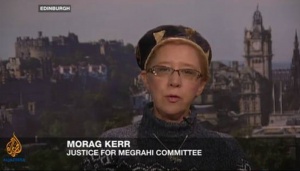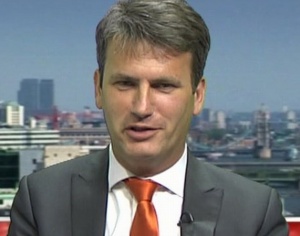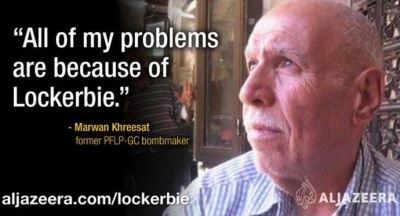Difference between revisions of "Patrick Haseldine"
(E-petitions) |
(→E-petitions: Adding image) |
||
| Line 31: | Line 31: | ||
==E-petitions== | ==E-petitions== | ||
| + | [[File:Lockerbie_Cameron.jpg|400px|right|thumb|[[David Cameron]] laying a wreath at the [[Lockerbie Bombing|Lockerbie Memorial]] in Dryfesdale Cemetery during a visit to Scotland on 15 May 2014]] | ||
In November 2013, Patrick Haseldine created an e-petition calling upon the British Government to: | In November 2013, Patrick Haseldine created an e-petition calling upon the British Government to: | ||
:"Support a United Nations Inquiry into the deaths of UN Secretary-General [[Dag Hammarskjöld]] and UN Assistant Secretary-General [[Bernt Carlsson]]" | :"Support a United Nations Inquiry into the deaths of UN Secretary-General [[Dag Hammarskjöld]] and UN Assistant Secretary-General [[Bernt Carlsson]]" | ||
The e-petition was open for signature by UK citizens and residents until 13 May 2014.<ref>[http://epetitions.direct.gov.uk/petitions/56550 "Support a United Nations Inquiry into the deaths of UN Secretary-General [[Dag Hammarskjöld]] and UN Assistant Secretary-General [[Bernt Carlsson]]"]</ref> | The e-petition was open for signature by UK citizens and residents until 13 May 2014.<ref>[http://epetitions.direct.gov.uk/petitions/56550 "Support a United Nations Inquiry into the deaths of UN Secretary-General [[Dag Hammarskjöld]] and UN Assistant Secretary-General [[Bernt Carlsson]]"]</ref> | ||
| − | In April 2014, | + | In April 2014, he created an e-petition addressed to the UN Secretary-General which is open for signature by anyone, regardless of nationality: |
:"Take action to investigate the deaths of UN Officials [[Dag Hammarskjöld]] and [[Bernt Carlsson]]!"<ref>[https://secure.avaaz.org/en/petition/United_Nations_SecretaryGeneral_Ban_Kimoon_Investigate_the_deaths_of_UN_Officials_Dag_Hammarskjold_and_Bernt_Carlsson/ "Take action to investigate the deaths of UN Officials Dag Hammarskjöld and Bernt Carlsson!]</ref> | :"Take action to investigate the deaths of UN Officials [[Dag Hammarskjöld]] and [[Bernt Carlsson]]!"<ref>[https://secure.avaaz.org/en/petition/United_Nations_SecretaryGeneral_Ban_Kimoon_Investigate_the_deaths_of_UN_Officials_Dag_Hammarskjold_and_Bernt_Carlsson/ "Take action to investigate the deaths of UN Officials Dag Hammarskjöld and Bernt Carlsson!]</ref> | ||
| − | On 14 May 2014, | + | On 14 May 2014, Patrick Haseldine sent this email to [[David Cameron]] via the [https://email.number10.gov.uk/ Prime Minister's Office:] |
:Dear Prime Minister, | :Dear Prime Minister, | ||
| Line 48: | Line 49: | ||
:2. http://www.change.org/en-GB/petitions/prime-minister-david-cameron-open-all-mi6-files-on-state-sponsored-murders/ | :2. http://www.change.org/en-GB/petitions/prime-minister-david-cameron-open-all-mi6-files-on-state-sponsored-murders/ | ||
:3. https://you.38degrees.org.uk/petitions/open-all-mi6-files-on-state-sponsored-murders/ | :3. https://you.38degrees.org.uk/petitions/open-all-mi6-files-on-state-sponsored-murders/ | ||
| − | :4. https://secure.avaaz.org/en/petition/Prime_Minister_David_Cameron_Open_all_MI6_files_on_state_sponsored_murders/ | + | :4.https://secure.avaaz.org/en/petition/Prime_Minister_David_Cameron_Open_all_MI6_files_on_state_sponsored_murders/ |
:I hope you can agree to open these [[MI6]] files to assist the UN in its reopened investigation. | :I hope you can agree to open these [[MI6]] files to assist the UN in its reopened investigation. | ||
Revision as of 11:05, 16 May 2014
Patrick Haseldine (born 11 July 1942) is a former British diplomat who was dismissed by the then foreign secretary, John Major, in August 1989.
Haseldine's dismissal resulted from his public criticism of prime minister, Margaret Thatcher, and from what he regarded as her government's acquiescence in the face of an act of state-sponsored terrorism by apartheid South Africa — the December 1988 Lockerbie Bombing.[1]
In October 2007, Haseldine petitoned Prime Minister Tony Blair for a United Nations Inquiry into the death of Lockerbie bombing victim, United Nations Commissioner for Namibia, Bernt Carlsson.[2] Two years later, he repeated the call for a United Nations Inquiry to Prime Minister Gordon Brown.[3]
In July 2013, Patrick Haseldine, who is often referred to as "Emeritus Professor of Lockerbie Studies", composed the WikiSpooks article The How, Why and Who of Pan Am Flight 103.
Contents
- 1 E-petitions
- 2 Published articles
- 3 Background
- 4 Diplomatic career
- 5 Political activity
- 6 Lockerbie sleuth
- 7 Petitioning HM Government
- 8 Lockerbie cover-up
- 9 Lockerbie, Luggage & Lies
- 10 Why Flight 103?
- 11 "Haselnut" rumbled by Private Eye
- 12 Al Jazeera's next film
- 13 Lockerbie-related articles
- 14 Press reports
- 15 References
- 16 See also
- 17 External links
E-petitions
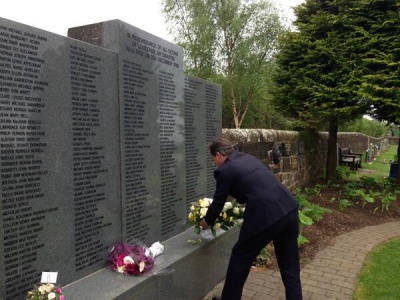
In November 2013, Patrick Haseldine created an e-petition calling upon the British Government to:
- "Support a United Nations Inquiry into the deaths of UN Secretary-General Dag Hammarskjöld and UN Assistant Secretary-General Bernt Carlsson"
The e-petition was open for signature by UK citizens and residents until 13 May 2014.[4]
In April 2014, he created an e-petition addressed to the UN Secretary-General which is open for signature by anyone, regardless of nationality:
- "Take action to investigate the deaths of UN Officials Dag Hammarskjöld and Bernt Carlsson!"[5]
On 14 May 2014, Patrick Haseldine sent this email to David Cameron via the Prime Minister's Office:
- Dear Prime Minister,
- My e-petition to HM Government had 56 signers when it closed yesterday. That petition requested HMG to "Support a United Nations Inquiry into the deaths of UN Secretary-General Dag Hammarskjöld and UN Assistant Sec-Gen Bernt Carlsson".
- On 13 May 2014, I created four new e-petitions each calling on you to "Open all MI6 files on state sponsored murders":
- 1. http://www.thepetitionsite.com/859/022/615/open-all-mi6-files-on-state-sponsored-murders/
- 2. http://www.change.org/en-GB/petitions/prime-minister-david-cameron-open-all-mi6-files-on-state-sponsored-murders/
- 3. https://you.38degrees.org.uk/petitions/open-all-mi6-files-on-state-sponsored-murders/
- 4.https://secure.avaaz.org/en/petition/Prime_Minister_David_Cameron_Open_all_MI6_files_on_state_sponsored_murders/
- I hope you can agree to open these MI6 files to assist the UN in its reopened investigation.
- Patrick Haseldine
- Emeritus Professor of Lockerbie Studies
Published articles
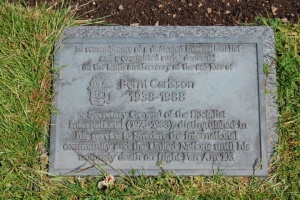
On 21 December 2013, The Ecologist magazine published an article by Patrick Haseldine entitled "Why Flight 103?".[6]
On 6 January 2014, The Ecologist published an article by Patrick Haseldine entitled "Flight 103: it was the Uranium"[7] which, on 7 January 2014, was published by Global Research under the heading "The Downing of Flight 103 over Lockerbie: It was the Uranium" with the attribution "Copyright Patrick Haseldine, The Ecologist, 2014".[8]
On 8 January 2014, the Namibian Sun summarised the article as "Lockerbie disaster kept Rössing in business".[9]
Issue No. 1358 of Private Eye magazine (24 January - 6 February 2014) carried an impetuous piece written by John Ashton about the 'conspiracy theorist' Haselnut and the editor of The Ecologist Oliver Tickell.[10]
Background
Born in Leytonstone, Haseldine attended St Ignatius' College (1953–1958), a grammar school in north London. Aged 16 and with seven GCE O'level passes, he left school and was employed for five years in banking and commerce in London. Another three years were spent as a production controller in a furniture manufacturing firm in Essex and at the Ford Motor Company in Dagenham.
In 1966, he successfully applied for a job that was advertised in the Daily Telegraph and spent the next three years at the office of the Australian Air Attaché in Paris, expediting the provision of aircraft spare parts for the Mirage and Mystère fighter aircraft that were in service with the Royal Australian Air Force. He met a Swiss girl, Eliane, and married her in Paris in April 1968. After his RAAF contract in Paris ended in late 1969, they moved to London but with the intention of working overseas again before long.
Diplomatic career
Haseldine made enquiries about joining the Foreign and Commonwealth Office and was advised that the best route would be to sit the 1970 Civil Service Open Competition qualifying examination. He scored high marks in the exam and succeeded in the subsequent Civil Service Selection Board interview. The whole recruitment process took over 15 months – during which time he was employed at the London headquarters of the United Kingdom Atomic Energy Authority – before he finally joined the HM Diplomatic Service on May 3, 1971. He enrolled in the Open University's first-year (1971) intake for the Science Foundation Course, and graduated in 1974.
His first FCO diplomatic posting was a welcome return to Paris in 1975, from where he was transferred in January 1978 to the British High Commission in Freetown, Sierra Leone until November 1982.
Haseldine was posted back to the FCO in London in January 1983. After completing the FCO's first mid-career development course, which was intended to convert "E" stream officers into "A" stream political high-flyers, he was appointed in July 1983 to be an assistant on the South Africa desk in the FCO's Southern African Department (SAfD). His responsibilities included monitoring the voluntary cultural and sports boycott of South Africa, and enforcing the mandatory UN arms embargo against South Africa. (United Nations Security Council Resolution 418 of 4 November 1977 prohibited the export of arms and related matériel to South Africa, and enjoined states not to co-operate with South Africa in the manufacture and development of nuclear weapons.)[11]
On 5 August 1983, Haseldine was formally commissioned into HM Diplomatic Service.
In September 1983, a new South Africa desk officer, Dr David Carter (his section head), was appointed. Haseldine was encouraged by Dr Carter to take a more relaxed view on exports to South Africa of certain types of dual purpose (military/civilian) equipment such as air traffic control radar systems. However, he was reluctant to recommend approval because such equipment was invariably designed for military use and the supporting 'end-use certificates' were inherently unreliable. On the other hand, Haseldine considered that the 'Open General Export Licence' system needed tightening up since it seemed to offer a loophole for British exporters to circumvent the arms embargo. For example, South African Airways (SAA) was allowed to export British aircraft spares up to a certain value without specifying what the spares were and for which aircraft they were destined. To remedy the situation, he proposed that SAA should be required to provide a detailed list of these aircraft spares but Dr Carter did not agree with his proposal and, as a result, gave him an adverse (Box 4) performance marking in the annual staff appraisal report. By continually seeking advice from other government departments (such as the Ministry of Defence or the Department of Energy), he managed to delay or avoid giving FCO approval for doubtful dual purpose export licence applications (ELAs) or for those ELAs that he suspected would assist South Africa's development of nuclear weapons.
On a Saturday at the end of March 1984, Haseldine attended his best man's church wedding in Coventry. After the wedding reception, he was amazed to read in the March 31, 1984 edition of the Coventry Evening Telegraph of the arrest of four South African arms smugglers (Coventry Four). Early on the following Monday, he brought a copy of the newspaper into the office to show to Jeremy Varcoe, the head of SAfD, only to find that 10 Downing Street had already summoned Mr Varcoe to explain the background to the incident, which had quickly become a major political embarrassment for Mrs Thatcher's government. Dr David Carter gave him an even worse adverse performance marking (Box 5) on his next staff report, which led to Haseldine's abrupt removal from SAfD in September 1984 and to a two-year secondment from the FCO to International Division of the Office of Fair Trading (OFT), where he was required to enforce the European Community Competition Rules (Articles 85 & 86 of the Treaty of Rome). Craig Murray, a new entrant to HM Diplomatic Service, replaced Haseldine in SAfD monitoring the sports boycott and enforcing the mandatory UN arms embargo against apartheid South Africa.
Departmental warning
Shortly after his arrival at the OFT, he was sent a letter by FCO personnel department warning that a further adverse report could result in his "premature retirement from the diplomatic service on the grounds of limited efficiency". Despite this initial setback, Haseldine settled in well and enjoyed his work at the OFT, where his performance was rated "very good" in the 1985 staff report. In a series of letters starting in January 1986, he complained to the FCO's Chief Clerk claiming that his performance in SAfD had been misjudged, that the adverse reports were both unfair and unjustified, and that as a result he had become unpromotable. He was not satisfied by the Chief Clerk's dismissive response, and took the matter up with his MP (Robert McCrindle), who in turn wrote to Foreign Office minister, Baroness Young.
In August 1986, FCO personnel department informed Haseldine that his next overseas posting in December 1986 would be back to West Africa as vice-consul in Douala, Cameroon. He left the OFT in September 1986 to undertake a number of pre-posting training courses. The Diplomatic Service Medical Adviser gave Haseldine medical clearance for the posting, arranged for his six-year-old son to jump the hospital waiting-list and have a tonsillectomy, and referred his wife to the Royal Marsden Hospital for breast cancer screening. After tests, the hospital booked Eliane in for a lumpectomy operation on December 10. She returned to the hospital on December 18 for removal of the stitches and was told that the biopsy was not cancerous. A month earlier, Haseldine had turned down personnel department's request for him to arrive in Douala a week before the visit by a London Chamber of Commerce and Industry trade mission on November 27, on the grounds that his family had not by then been medically cleared to travel. On December 1, 1986 Haseldine was summoned to personnel department, told that the Douala posting was cancelled because he had not arrived there on the weekend of November 21/22, was warned that he could now face disciplinary proceedings and would have to remain in London for at least 18 months. On December 29, 1986 Haseldine was appointed to Defence Department of the FCO as Africa desk officer, controlling the £13 million budget for the UK military training assistance scheme (UKMTAS).
It was not until December 31, 1986 that Lady Young responded to his MP:
- "We do not normally reveal the contents of confidential reports to others than the officer concerned at his appraisal interview. But given Mr Haseldine's persistence I think that in this case it is right that you should know the facts.
- "Mr Haseldine's major weaknesses were in his power of analysis, where he consistently failed to get to the heart of the matter; his general lack of political sense; his judgement, which was partially affected by his poor grasp of his subjects; his lack of initiative and his inability to distinguish between key issues and minor ones. In all these areas Mr Haseldine was marked at point five on a scale of six. His marks for ability to produce constructive ideas, political sense, foresight, reliability, accuracy and expression on paper were at point four on the same scale, all below the median line. In the accompanying pen picture, he was described as cheerful, hardworking, and well-intentioned, but lacking in intellectual horsepower. He was considered miscast in that particular job, and, frankly, out of his depth.
- "I am sure you will appreciate Southern African Department is an important department where good powers of analysis and a high level of political sense is required. Mr Haseldine's report did not deny his skills and abilities in certain areas but suggested they would be better harnessed in more ordered and orderly work than that provided in a fast-moving political department. This has proved to be the case as Mr Haseldine has just completed two successful years on secondment to the Office of Fair Trading.
- "Finally, I must point out that there is no question that Mr Haseldine was downgraded as a result of this report. He was not downgraded in any way. He was merely assessed as not yet qualified for promotion to the next higher grade, a situation on which I am glad to say we have been able to improve, on the strength of his more recent reports."
BBC Question Time
On February 25, 1988 Patrick Haseldine was a member of the invited studio audience of the BBC television topical program Question Time which began transmission at 22:00. Fifteen minutes into the program a student raised a question about that day's outlawing of 17 anti-apartheid organisations, and asked whether the British government was justified in its opposition of economic sanctions against South Africa in the face of calls for sanctions by Nelson Mandela, Bishop Tutu and by most of the European Community. The Question Time panel (Shirley Goodwin of the Health Visitors Association, Sir Russell Johnston - Liberal party spokesman on foreign affairs, Michael Meacher MP - Labour's shadow employment secretary and Michael Portillo MP junior minister at the DHSS) discussed the matter for nine minutes before the host Sir Robin Day asked if anyone in the audience had anything to add. Without identifying himself, Haseldine intervened in the discussion and posed the following question:
- "Now that peaceful opposition has been outlawed in South Africa what active measures should Britain (the leading investor and major trading partner) take to avoid the seemingly inevitable violent upheaval which will ensue in South Africa?"
Sir Robin asked what measures Haseldine had in mind and, because no suggestions were forthcoming, put the question back to the panel. Their discussion was then prolonged by a further three minutes until 22:30 when Sir Robin asked the audience to raise their hands if they were in favour of economic sanctions against South Africa. Haseldine was on camera as a large majority of the audience voted for sanctions.
As a result of his Question Time appearance, Haseldine was suspended from his job in the Defence Department for six months. [12]
Criticism of Thatcher
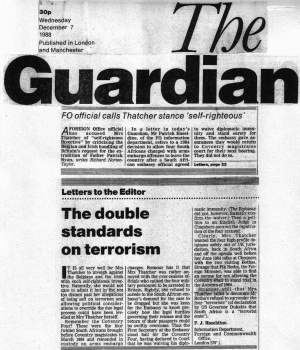
FCO Personnel Department invited Patrick Haseldine back to join Information Department on September 3, 1988.
Three months later, Haseldine wrote a letter on FCO notepaper to The Guardian newspaper which was published on December 7, 1988 under the heading "The double standards on terrorism", in which he criticised prime minister Margaret Thatcher for being soft on South African state-sponsored terrorism. The day before publication, journalist Richard Norton-Taylor rang Haseldine at work to verify his identity and confirm his intention for the letter to be published. Publication came just fourteen days before the Lockerbie Bombing, responsibility for which Haseldine would later attribute to apartheid South Africa. The front page of The Guardian carried the following article:
- FO official calls Thatcher stance 'self-righteous'
- "A Foreign Office official has accused Mrs Thatcher of 'self-righteous invective' by criticising the Belgian and Irish handling of Britain's request for the extradition of Father Patrick Ryan, writes Richard Norton-Taylor. In a letter in today's Guardian, Mr Patrick Haseldine, of the FO information department, refers to a 1984 decision to allow four South Africans charged with arms embargo offences to leave the country after a South African embassy official agreed to waive diplomatic immunity and stand surety for them. The embassy gave assurances they would return to Coventry magistrates court for their next hearing. They did not do so. Letters, page 22"
Text of Haseldine's letter: [13][14][15][16]
The double standards on terrorism
- It is all very well for Mrs Thatcher to inveigh against the Belgians and the Irish with such self-righteous invective. Naturally, she would not care to admit it but in the not too distant past her allegations of being soft on terrorism and allowing political considerations to override the due legal process could have been levelled at Mrs Thatcher herself.
- Remember the Coventry Four? These were the four (white) South Africans brought before Coventry magistrates in March 1984 and remanded in custody on arms embargo charges. Rumour has it that Mrs Thatcher was rather annoyed with the over-zealous officials who caused the four military personnel to be arrested in Britain. Rightly, she refused to accede to the South African embassy's demand for the case to be dropped but she was keen for the embassy to know precisely how the legal hurdles governing their release and the return of their passports could be swiftly overcome. Thus the First Secretary at the embassy stood bail for the Coventry Four, having declared in court that he was waiving his diplomatic immunity. (The embassy did not, however, formally confirm the waiver.) Then a petition to an English Judge in Chambers secured the repatriation of the four accused.
- Clearly, Mrs Thatcher wanted the four high-profile detainees safely out of UK jurisdiction, back in South Africa and off the agenda well before her June 1984 talks at Chequers with the two visiting Bothas (P W Botha and Pik Botha). Strange that Pik Botha, the foreign minister, was able to find an excuse for not allowing the Coventry Four to stand trial in the Autumn of 1984.
- Stranger still that Mrs Thatcher failed to denounce Mr Botha's refusal to surrender the four 'terrorists' (cf declaration by U.S. Governor Michael Dukakis that South Africa is a 'terrorist state'[17]).
Political reaction
Questions about Haseldine's letter to The Guardian were asked in Parliament by eight Labour MPs: Richard Cabourn, Dale Campbell-Savours, Bob Cryer, Tam Dalyell, Tony Lloyd, Dennis Skinner, Alan Williams and David Winnick. The latter asked the Leader of the House (Mr Wakeham) on December 8, 1988:
- "Is it not a matter of public anxiety that there is so much prime ministerial pressure on the FCO to appease the apartheid regime that an information officer at the FCO came to the conclusion that he was willing to sacrifice his career because he believed that the truth ought to be told? Should not the prime minister, or at least the foreign secretary, make a statement before the recess, and is it not the case that, when the new Official Secrets Bill becomes law, the official in question will have no defence in claiming public interest?"
In a House of Commons debate on December 13, 1988 Tam Dalyell asked the Prime Minister:
- "when she expects to receive the report from Sir Robin Butler on the case of Mr P J Haseldine and his letter to The Guardian; and if she will make a statement"?
Mrs Thatcher replied:
- "I do not expect to receive such a report. This case is being considered in accordance with procedures laid down in diplomatic service regulations. These regulations are made under powers vested in the Foreign and Commonwealth Secretary by the Diplomatic Service Order in Council 1964 which established the diplomatic service as a separate service under the Crown."
Media reaction
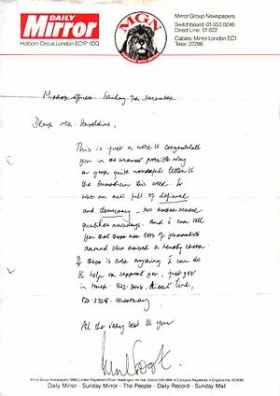
On December 9, 1988 Paul Foot of the Daily Mirror sent Haseldine the hand-written letter pictured right:
- "Dear Mr Haseldine,
- This is just a note to congratulate you in the warmest possible way on your quite wonderful letter to The Guardian this week. It was an act full of defiance and democracy - two rather scarce qualities these days. And I can tell you that there are lots of journalists around who raised a hearty cheer.
- If there is ever anything I can do to help or support you, just get in touch.
- All the very best to you, [signed] Paul Foot." [18]
Time Magazine reported:
- "Few doubt that the Thatcher government has grown more rigid as it has aged. Last month, for example, the government revealed a revised version of the Official Secrets Act: one clause outlaws disclosure of any information by a member or former member of the security or intelligence services and rules out the claim of a higher national interest as a defense in a court of law. Even revelations of criminal behavior by officials would be illegal, and journalists who publish such material could be prosecuted. So determined is the government to silence leakers that a senior Foreign Office official was suspended last week and faces dismissal for writing a letter to a newspaper accusing Thatcher of 'self-righteous invective'."
The Guardian reported on December 17, 1988 that a fifth man had been arrested in March 1984, at the same time as the Coventry Four, but was quickly released without charge on instructions from senior Whitehall officials. Professor Johannes Cloete of Stellenbosch University admitted he was the fifth man but denied that he or the Kentron employees arrested with him had broken any British law. [19]
Disciplinary Hearing
Upon publication of the Guardian letter Personnel Department again suspended Haseldine, sent him a letter of complaint in accordance with diplomatic service regulation (DSR) number 20 and scheduled an internal FCO disciplinary hearing to take place on February 28, 1989. In advance of this hearing, Haseldine wrote on January 23, 1989 to Sir Robin Day asking for a video recording of the program in which he had appeared. The editor of Question Time, Barbara Maxwell, sent him Sir Robin's own VHS copy together with a covering letter sympathising with his predicament.
Haseldine attended the FCO hearing with his solicitor, Pamela Walsh, and brought along the video – extracts of which were screened there. The disciplinary board's questioning was largely focused on the Guardian letter and Haseldine was repeatedly asked to divulge the source of the information in the letter. However, because he had been led to believe he was under an Official Secrets Act, 1911 criminal investigation, he refused to be drawn on the matter lest he incriminate himself in advance of the trial.
The disclipinary board reported on March 7, 1989 to the Permanent Under-Secretary (PUS) at the FCO. In the unpublished report, the board said its task was defined solely by DSR 20 and the letter of complaint, which excluded consideration of the Question Time issue, and it agreed unanimously that the only appropriate penalty in Haseldine's case was enforced resignation or dismissal. On March 21, 1989 the PUS wrote to Haseldine saying he should resign by – or be dismissed on – April 4, 1989 when payment of his salary would cease.
Dismissal
Haseldine appealed against this decision in a letter dated March 22, 1989 to the foreign secretary, Sir Geoffrey Howe. He also wrote on April 5 1989 to his MP, Robert McCrindle, firstly complaining that the FCO had just ceased paying his salary and secondly accusing South Africa of responsibility for the Lockerbie bombing. The No 2 Diplomatic Service Appeal Board (comprising Dame Gillian Brown, Mr N H Young, Mr W Jones and Mr J P R Oliver) met on May 5, 1989. Accompanied this time by his wife, Haseldine attended the meeting still expecting to be charged under the Official Secrets Act, and therefore again constrained in what he could say about the source of the information in his Guardian letter. The Appeal Board had before it the correspondence with Mr McCrindle and stated in its unpublished written record (paragraph 67):
- "Mr Jones said Mr Haseldine had raised the point of South Africa being the cause of his problems. He often referred to South Africa eg he had himself linked South Africa to the Lockerbie disaster."
At the start of the summer parliamentary recess on July 19, 1989 Sir Geoffrey Howe's private secretary, Stephen Wall, wrote informing Haseldine that his appeal had been rejected and that he should submit his resignation by August 2, 1989 or be dismissed on that date. He did not resign and the private secretary wrote again on August 4, 1989 (four days after Sir Geoffrey Howe had been demoted and replaced as foreign secretary by John Major) confirming that Haseldine had in fact been dismissed from the Diplomatic Service on August 2, 1989.
Haseldine v United Kingdom
The Guardian of August 3, 1989, in an editorial with the title "Just out of court", argued that Haseldine's dismissal could well have been a breach of Article 10 (freedom of expression) of the European Convention on Human Rights. Encouraged by this editorial, he and his solicitor began preparing an application to the European Commission of Human Rights (ECHR) in Strasbourg. The Haseldine v United Kingdom application – which on his solicitor's advice made no reference to the Lockerbie bombing – was eventually submitted in 1991. The ECHR declared it inadmissible the following year.[20]
Political activity
Seeking a political home for his anti-apartheid views, Haseldine joined the Labour Party in 1990 and, as soon as the party rules permitted, became a Labour candidate for the Ongar Division in the May 6, 1993 Essex County Council elections. He came third, but with a respectable vote. In the build-up to the 1994 European Parliament elections, he narrowly failed in his attempt to secure the nomination in his local Essex West & Hertfordshire East constituency. Instead, he became press officer to the successful nominee, Hugh Kerr. The subsequent tightly fought contest in this rural euro-constituency (not Labour's natural territory) resulted in Kerr's surprise election as a Member of the European Parliament (MEP) and the defeat of the Conservative incumbent Patricia Rawlings. At about the same time, Haseldine was elected as Chipping Ongar's first Labour parish councillor. As the proprietor of the Clock Tower Café in Ongar, he hosted a number of annual dinners for local Labour Party members. Among the guest speakers there, were Hugh Kerr MEP and Bill Rammell prospective Labour candidate and, from 1997, Member of Parliament for the Harlow constituency.
With the demise of the apartheid regime in South Africa and the election there of Nelson Mandela in April 1994, Haseldine decided to seek reinstatement in HM Diplomatic Service. On the fifth anniversary of his dismissal by John Major – who was foreign secretary in 1989 and had since become Prime Minister – Haseldine decided he would present an "ultimatum" to 10 Downing Street. His letter of July 19 1994 offered Prime Minister Major the choice of either agreeing to reinstate him or, failing such agreement, the alternative of resigning as PM within fourteen days or of being dismissed at the next election. In the event, he was not re-employed and the PM did not resign. Therefore Haseldine had to consider how best he could dismiss the PM. After deliberating upon the options, he chose to stand as Labour party candidate against the Conservative MP in his Huntingdon constituency at the next General Election. He did not realistically expect to overturn Major's 36,230-vote majority, one of the largest in the country, but thought he could make a sizeable dent in it. Haseldine contacted the Huntingdon constituency Labour party (CLP) and was invited with four other candidates to address the CLP parliamentary selection meeting on March 14, 1995. He attended the Huntingdon selection meeting but a young local school teacher, Jason Reece, was preferred and adopted as Labour's candidate.
Reece failed to overturn Major's majority at Huntingdon but did hit the headlines during the election campaign when his school sacked him for standing against the PM. Reece sued the Jack Hunt School in Peterborough for breach of contract and was awarded £700. Reece told The Guardian of December 2, 1996:
- "I hope this has established the right of any citizen to stand for Parliament without having to worry whether their employer approves."
Major retained his Huntingdon seat in the 1997 General Election, but his majority was halved to 18,140 (Reece came second with 13,361 votes). Although Haseldine was unsuccessful in sacking John Major MP, he helped to "sack the PM" since Major's Tory government was resoundingly defeated by a resurgent Labour party headed by Tony Blair in 1997. [21]
Contact with New Labour
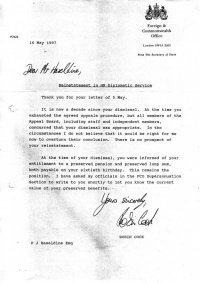
On May 5, 1997 Haseldine wrote congratulating new foreign secretary Robin Cook on his appointment, after the landslide election victory of the New Labour government, and asking for reinstatement in the FCO. The foreign secretary replied in a letter dated May 16, 1997:
- "It is now a decade since your dismissal. At the time you exhausted the agreed appeal procedures, but all members of the Appeal Board, including staff and independent members, concurred that your dismissal was appropriate. In the circumstances I do not believe it would be right for me now to overturn their conclusion. There is no prospect of your reinstatement."
Undaunted, he then asked his MP (Eric Pickles) and MEP (Hugh Kerr) to intercede with Robin Cook on his behalf. When neither representative managed to elicit a positive response from the foreign secretary, Haseldine sent a letter via the South African High Commission addressed to President Nelson Mandela, who was visiting London in July 1997 for talks with PM Tony Blair. The letter, which he copied to 10 Downing Street, dealt with his twin concerns: Lockerbie/South Africa and reinstatement in the FCO. No 10 did not respond, and it was not until August 22, 1997, that Mandela's administrative secretary wrote from Cape Town acknowledging receipt of Haseldine's letter, and saying:
- "The matter will be brought to the President's attention as soon as possible."
At which point Haseldine decided to abandon political activity and to concentrate on pursuing the former apartheid regime by the judicial route.
Lockerbie sleuth
Patrick Haseldine first suspected the involvement of the apartheid regime in the Lockerbie Bombing when he heard South African foreign minister Pik Botha's interview with the BBC Radio 4 Today Programme on January 11, 1989. On that day Botha – along with other international representatives including UN Secretary-General Javier Pérez de Cuéllar – was in Stockholm to attend the memorial service for Bernt Carlsson, UN Commissioner for Namibia. Botha told the BBC that he had been forced to make a last-minute change in his own booking on Pan Am Flight 103 because of a warning by an intelligence source that he (Botha) was being targeted by the African National Congress (ANC). Using this information, which had not been reported elsewhere in the media, Haseldine wrote another letter to The Guardian on December 7, 1989:
Finger of suspicion
- "Exactly one year ago, you published my letter suggesting that Mrs Thatcher might have a blind spot as far as South African terrorism is concerned. Fourteen days after publication, Pan Am Flight 103 was blown out of the sky upon Lockerbie. Of the 270 victims, the most prominent person was the Swede Mr Bernt Carlsson – UN Commissioner for Namibia – whose obituary appeared on page 29 of your December 23, 1988 edition.
- "I cannot be the only puzzled observer of this tragedy to wonder why police attention did not immediately focus on a South African connection. The question to be put (probably to Mrs Thatcher) is: given the South African proclivity to using the diplomatic bag for conveying explosives and the likelihood that the bomb was loaded aboard the aircraft at Heathrow (vide David Pallister, The Guardian, November 9, 1989) why has it taken so long for the finger of suspicion to point towards South Africa?
- "Were police inquiries into Lockerbie subject to any political guidance or imperatives?
- Patrick Haseldine
- (Address supplied) [22]
Haseldine's media campaign continued with The Guardian publishing a further ten letters, referenced below, linking apartheid South Africa to the sabotage of Pan Am Flight 103.
Judicial campaign
Patrick Haseldine's judicial campaign started on September 26, 1990 when he sent a 3-page letter to Sheriff Principal John Mowatt QC (who presided over the Fatal Accident Inquiry that was to start on October 1, 1990), outlining the case against South Africa. In reply the Regional Sheriff Clerk at Dumfries wrote on October 2, 1990:
- "The criminal investigation into the Lockerbie air disaster is a matter for the Lord Advocate alone and cannot in any way be influenced by the Court."
Haseldine then wrote to the Lord Advocate, Lord Fraser of Carmyllie, on October 18 and again on November 5, 1990. The Crown Office replied on November 21, 1990 saying:
- "It is not the practice of the Lord Advocate to make statements in relation to the direction of a criminal investigation. Your letters have, however, been passed to the Procurator Fiscal who is responsible not only for the conduct of the Fatal Accident Inquiry but also for the conduct of the criminal investigation."
Dossier of evidence
In 1994, Patrick Haseldine began assembling a dossier of evidence to incriminate South Africa for the Lockerbie bombing, rather than the two Libyans (Megrahi and Fhimah) who had been indicted for the crime three years earlier.
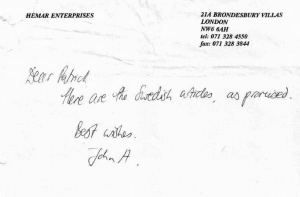
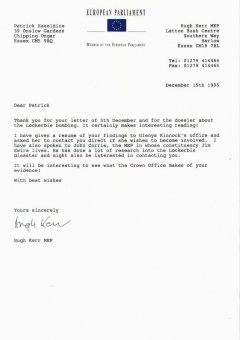
Following publication on 22 December 1993 of his tenth letter to The Guardian,[23] Haseldine was invited to meet John Ashton who was researching material for the documentary film The Maltese Double Cross - Lockerbie. John Ashton told him about a Swedish newspaper article on Bernt Carlsson and promised to let him have an English translation of it. Haseldine got in touch with Swedish journalist Jan-Olof Bengtsson who had written three articles in the iDAG newspaper in March 1990 about UN Commissioner for Namibia, Bernt Carlsson. The main thrust of these Swedish articles appeared to be that South African pressure had been applied to Carlsson so that he would take Pan Am Flight 103. Bengtsson mailed the articles to him from Malmö following a fax dated November 23, 1995:
- "Dear Mr Haseldine, Have just received your fax and you'll have copies of my three articles published in iDAG in the mail at once. As you understand they are in Swedish so you have to translate them.
- "The articles were published as follows – 1990-03-12, 1990-03-13 and 1990-03-14.
- "I would very much like to have the articles/letters you've published in The Guardian before and after the explosion.
- "I don't know the British regulations of how to use articles and press materials in your court system as evidence. But if you find my articles and 'digging' helpful supporting your theories, you have my permission to use them in any way you want.
- "Yours sincerely,
- "Jan-Olof Bengtsson" [24]
John Ashton also sent Haseldine a video cassette recording of the 1994 documentary film "The Maltese Double Cross" from which he noted that foreign minister Pik Botha as well as a South African delegation had reportedly been booked on Pan Am Flight 103, but had cancelled at the last minute. To find out more, he contacted Reuters in London and obtained a copy of the news agency's press release issued in Johannesburg on 12 November 1994 in which Botha's spokesman confirmed the booking on Pan Am 103 but denied that Pik Botha had foreknowledge of a bomb on the aircraft.[25]
In December 1995, Haseldine incorporated this and other evidence he had accumulated into his dossier entitled "Lockerbie bombing: new evidence to confirm South Africa's involvement", and presented it to the Scottish Lord Advocate; the U.S. embassy; the South African High Commission; Dr Jim Swire of UK Families Flight 103; his MEP, Hugh Kerr; his MP, Eric Pickles and Robin Cook, shadow foreign secretary. All, except the latter, acknowledged receipt.
On 15 December 1995, Hugh Kerr replied as follows:
- Dear Patrick
- Thank you for your letter of 5th December and for the dossier about the Lockerbie bombing. It certainly makes interesting reading!
- I have given a resumé of your finding's to Glenys Kinnock's office and asked her to contact you direct if she wishes to become involved. I have also spoken to John Corrie, the MEP in whose constituency Jim Swire lives. He has done a lot of research into the Lockerbie disaster and might also be interested in contacting you.
- It will be interesting to see what the Crown Office makes of your evidence!
- With best wishes
- Yours sincerely
- Hugh Kerr MEP
In his letter dated 13 February 1996, J A Dunn, Senior Legal Assistant in the Crown Office, told Patrick Haseldine:
- "Although everything you say has been considered in relation to the Lockerbie criminal investigation, I have to advise you the the four items which you have described as new pieces of evidence do not provide the evidential basis which would be required for bringing charges against anyone."
Trial of two Libyans
Haseldine continued to update the dossier and eventually emailed it (a single-page report entitled Lockerbie bombing: further evidence to implicate South Africa together with 14 attachments) in March 2000 – two months before the start of the Pan Am Flight 103 bombing trial – to the newly-appointed Lord Advocate, Colin Boyd QC, and to the defence lawyers for the two accused Libyans. The report highlighted comments made by Anton Alberts, a law lecturer, at the September 1998 South African Truth and Reconciliation Commission (TRC) hearing into the 1982 bombing of the ANC's offices in London (for which apartheid-era superspy, Craig Williamson, and seven former agents of the Civil Cooperation Bureau (CCB) applied for and were granted amnesty).[26] Alberts was reported to have said:
- "If you look at the Lockerbie disaster - this is very similar. I think Britain would like to see these guys are prosecuted in England even though they get amnesty here."[27]
He became a regular contributor to the (now defunct) Pan Am 103/Lockerbie Discussion Forum website and in December 2000 published an article there with the title "Lockerbie Trial: A Better Defence of Incrimination".[28]
The Lockerbie bombing trial resulted in the acquittal of Al Amin Khalifa Fhimah and the conviction of Abdelbaset al-Megrahi on January 31, 2001. Megrahi's appeal against his conviction was rejected on March 14, 2002.
SCCRC review
Haseldine heard in 2004 that the Scottish Criminal Cases Review Commission (SCCRC) had been asked to undertake a thorough and impartial review of the case.[29] As a result, he made an extensive submission to the SCCRC in 2005 of all the evidence he had accumulated since 21 December 1988 to support the theory that the apartheid South African regime was responsible for the Lockerbie bombing. On 30 April 2007 he belatedly sent the SCCRC a printout of the March 2000 dossier that he had addressed to the Lord Advocate.
On June 28, 2007 the SCCRC concluded its four-year review and, having uncovered evidence that a miscarriage of justice could have occurred, the Commission granted Megrahi leave to appeal against his Lockerbie bombing conviction for a second time. Megrahi's legal team, who conducted their own investigation of the case in parallel to the SCCRC's review, were expected to tell the appeal judges that the entire case was flawed. His solicitor, Tony Kelly, said:
- "There's not one aspect of the case that's been left untouched."[30]
Second appeal
New information casting fresh doubts about Megrahi's conviction was examined by three judges at a preliminary hearing in the Appeal Court in Edinburgh on October 11, 2007:
- His lawyers claimed that vital documents, which emanate from the CIA and relate to the MEBO timer that allegedly detonated the Lockerbie bomb, were withheld from the trial defence team.[31]
- Tony Gauci, chief prosecution witness at the trial, was alleged to have been paid $2 million for testifying against Megrahi.[32]
- MEBO's owner, Edwin Bollier, has revealed that in 1991 the FBI offered him $4 million to testify that the timer fragment found near the scene of the crash was part of a MEBO MST-13 timer supplied to Libya.[33]
- Former employee of MEBO Ulrich Lumpert swore an affidavit in July 2007 saying that he had given false evidence at the trial concerning the MST-13 timer[34]
The second appeal was expected to be heard by five judges in the Court of Criminal Appeal in 2008. However, Megrahi abandoned the appeal upon being granted "compassionate release" from prison in Scotland and returning to Libya on August 20, 2009[35]
Petitioning HM Government
Freedom of expression
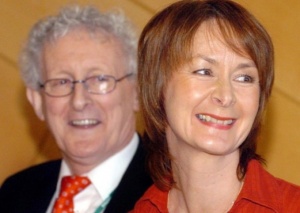
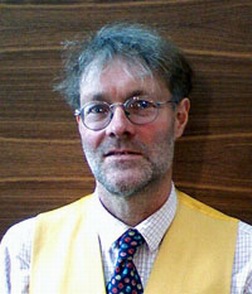
In December 2006, Patrick Haseldine petitioned prime minister Tony Blair, claiming his ECHR Article 10 right to freedom of expression was breached twice by the FCO in 1988. In the petition, Haseldine sought an amount of compensation "on a par with the out-of-court settlement made in February 2006 to former Scottish police detective, Shirley McKie" (£750,000).[36]
- We the undersigned petition the Prime Minister to compensate and substantially increase the FCO pension of British diplomat, Patrick Haseldine, who was sacked for writing a letter to The Guardian 18 years ago.
- The full background and justification for this petition are set out in Patrick Haseldine's Wikipedia article. We believe that Patrick Haseldine was wrongfully dismissed from HM Diplomatic Service on 2 August 1989, having written a letter that was published in The Guardian newspaper on 7 December 1988. His sacking, and prior suspension for six months for appearing on BBC TV's "Question Time" on 25 February 1988, clearly constitute interferences with his Article 10 right to freedom of expression. Accordingly, Haseldine should be paid not only ex gratia compensation (on a par with the out-of-court settlement made in February 2006 to former Scottish police detective, Shirley McKie - see her eponymous Wikipedia article) but also a significantly enhanced FCO pension.
100 signatures (minimum) were required for the petition to be eligible for consideration by the Prime Minister Tony Blair. There were 126 signatures by the 22 February 2007 closing date, including:
- Human rights lawyer Sir Geoffrey Bindman
- Iain McKie, father of Shirley McKie
- Peter Preston, former editor of The Guardian
- Scottish Education Secretary Michael Russell MSP
- UK Families Flight 103 spokesman Dr Jim Swire
- Environmentalist Oliver Tickell, editor of The Ecologist
- Labour MP David Winnick
In March 2007, the rules were changed retrospectively (and inexplicably) requiring a minimum of 200 signatures on a petition to the Prime Minister. As a result, no compensation has ever been paid to Patrick Haseldine nor has his meagre FCO pension ever been increased.
Friends and benefactors are invited to donate funds to P J Haseldine, International Bank Account Number GB42 CPBK 0891 0401 0801 13 (Bank Identification Code CPBK GB22).
Letter to Tony Blair
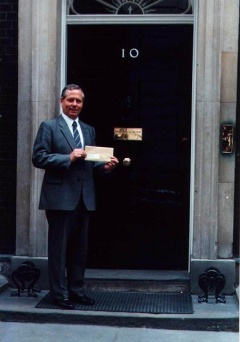
Several months later, and still without a response to his petition, he sent the following letter to Tony Blair at Downing Street on June 4, 2007[37]:
- "Dear Prime Minister,
- "The attached e-petition had 126 signatures when it closed on February 22, 2007. At that date, the petitions guide stated:
- "When a serious petition closes, provided there are 100 signatures or more, officials at Downing Street will ensure you get a response to the issues you raise. Depending on the nature of the petition, this may be from the Prime Minister, or he may ask one of his Ministers or officials to respond. We will email the petition organiser and everyone who has signed the petition via this website giving details of the Government's response.
- "As the petition organiser, I am very concerned about this revision which has recently been made to the guide:
- usually provided there are 200 signatures or more.[38]
- "My concern over this apparent moving of the goalposts will doubtless be shared by many other signatories including:
- human rights lawyer, Sir Geoffrey Bindman;
- Scottish Minister for Environment, Michael Russell MSP;
- former editor of The Guardian, Peter Preston;
- spokesman for UK Families Flight 103 Dr Jim Swire; and
- David Winnick MP.
- "To allay this concern, we should be grateful if you could arrange for Downing Street officials to email each of the 126 signatories with details of your Government's response to our petition for an enhanced FCO pension and ex-gratia compensation.
- "I am copying this letter to the above-mentioned signatories, and to Alan Rusbridger, editor of The Guardian.
- "Yours sincerely,
- "Patrick Haseldine"
Failing to acknowledge Haseldine's letter, Tony Blair resigned as Prime Minister on June 27, 2007.
Second e-petition
Meanwhile, a number of signatories suggested to Haseldine that the recent doubling from 100 to 200 signatures could simply be a ploy by Downing Street to avoid having to respond to his petition. Therefore, without waiting for what he anticipated would be an obfuscatory prime ministerial reply, Haseldine decided on June 14, 2007 to create this second e-petition:
- "We the undersigned petition the Prime Minister to say why the number of e-petition signatures needed to trigger a response by officials at Downing Street was recently changed from 'provided there are 100 signatures or more' to 'usually provided there are 200 signatures or more'."[39]
The petition opened on June 20, 2007 and, within a few hours, the following text had appeared in place of a signature:
- "Unaccountable and inconsistent. Petitions are removed, ignored, whatever upon the whim of 'the team'."
Haseldine immediately emailed the Number 10 web team requesting the removal of this apparent vandalism. But – as was the case with the first e-petition – received no email response from Downing Street, nor any action taken to remove the offending text from the second e-petition. The vandalised petition closed on September 20, 2007 with 15 signatures.
United Nations Inquiry
In October 2007, Haseldine submitted this e-petition to prime minister Gordon Brown:
- "We the undersigned petition the Prime Minister to support calls for a United Nations Inquiry into the death of UN Commissioner for Namibia, Bernt Carlsson, in the 1988 Lockerbie bombing.
- "Dr Hans Koechler, UN observer at the Pan Am Flight 103 bombing trial, has described Mr al-Megrahi's conviction as a 'spectacular miscarriage of justice'. If, as now seems inevitable, the Libyan's conviction is overturned on appeal, Libya will be exonerated and a new investigation is going to be required.
- "Apartheid South Africa is the prime alternative suspect for the Lockerbie Bombing - see South Africa luggage swap theory.
- "We understand that, when Libya takes its seat at the UN Security Council in January 2008, there will be calls for an immediate United Nations Inquiry into the death of UN Commissioner for Namibia, Bernt Carlsson, in the 1988 Lockerbie bombing. The other 14 UNSC members — including Britain — should support such an Inquiry and nominate Dr Koechler to conduct it." [40]
Dual UN Inquiry
In November 2013, former diplomat Patrick Haseldine created this e-petition calling upon HM Government (Foreign and Commonwealth Office) to:
- "Support a United Nations Inquiry into the deaths of UN Secretary-General Dag Hammarskjöld and UN Assistant Secretary-General Bernt Carlsson"
- On 9 September 2013, the London-based Hammarskjöld Commission reported that there was "significant new evidence" about the plane crash that killed United Nations Secretary-General Dag Hammarskjöld and recommended that the adjourned 1962 UN Inquiry should now be reopened.
- UN Assistant Secretary-General Bernt Carlsson was the highest profile victim on Pan Am Flight 103 which was sabotaged over Lockerbie on 21 December 1988.
- Since Bernt Carlsson's death has never been investigated, the British Government should propose extending the remit of the new UN Inquiry to cover the deaths of both senior diplomats: Dag Hammarskjöld and Bernt Carlsson.
The e-petition is open for signature by UK citizens and residents from 13 November 2013 to 13 May 2014, and can be signed here.
Lord Kinnock's response
On 12 December 2013, Lord Kinnock responded to Haseldine's email requesting his support for the Dual UN Inquiry, as follows:
- Dear Prof Haseldine,
- Thank you for your note.
- I am prepared to support the call for an UN Inquiry.
- Regards,
Lockerbie cover-up
When Pan Am Flight 103 was sabotaged over Lockerbie, Scotland on 21 December 1988 killing all 259 passengers and crew on board the Boeing jumbo jet, and eleven people in the town of Lockerbie, newspaper reports quickly identified Bernt Carlsson as the highest profile Pan Am Flight 103 victim:
- The New York Times of Thursday, 22 December 1988 reported:
- U.N. Officer on Flight 103
- "Bernt Carlsson, who was a passenger on the Pan Am flight that crashed over Scotland, had served as chief administrative officer of the United Nations Council for Namibia since July 1987. He was on his way here for a ceremony on Thursday, at which accords providing for Namibia's independence are to be signed by Angola, Cuba and South Africa. The officer is, in theory, the United Nations' appointed governor for Namibia, the South African-ruled territory also known as South-West Africa. But because United Nations authority over Namibia is not recognised by South Africa, he is in practice the chief United Nations officer in charge of development programs intended to prepare Namibia for independence.
- "Mr Carlsson, a 51-year-old Swedish diplomat, had been in London for a meeting with non-governmental groups, United Nations officials said. He telephoned his office from the boarding gate at Heathrow Airport before the flight to New York.
- "From 1983 to 1985 Mr Carlsson served as a Swedish Ambassador at Large to the Middle East. He was General Secretary of the Socialist International, the world federation of socialist and social democratic parties, from 1976 to 1983. From 1983 to 1985, he was an Ambassador at Large and special emissary of Prime Minister Olof Palme to the Middle East and Africa. He also served as international secretary of the Swedish Social Democratic Party and as Under Secretary of State for Nordic Affairs in the Swedish Foreign Ministry."[41]
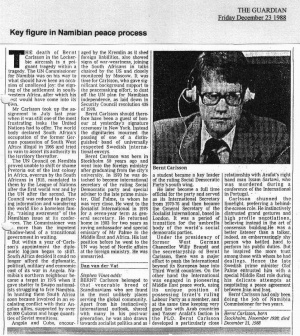
- Bernt Carlsson's Obituary appeared in The Guardian of 23 December 1988:[42]
- Key figure in Namibian peace process
- "The death of Bernt Carlsson in the Lockerbie aircrash is a poignant tragedy within a tragedy. The UN Commissioner for Namibia was on his way to what should have been an occasion of unalloyed joy: the signing of the settlement in south-western Africa, after which his post would have come into its own.
- "Mr Carlsson took up the assignment in July last year when it was still one of the most frustrating tasks the United Nations had to offer. The world body declared South Africa’s occupation of the former German possession of South West Africa illegal in 1966 and tried in vain to assert its authority in the territory thereafter.
- "The UN Council on Namibia proved unable to shift or shame Pretoria out of the last colony in Africa, overrun by the South Africans in 1915, mandated to them by the League of Nations after the first world war and by the UN after the second. The Council was reduced to gathering information and wandering the world like a homeless family, "raising awareness" of the Namibian issue at its conferences. The Commissioner was no more than the impotent shadow-head of a transitional government in waiting.
- "But within a year of Carlsson’s appointment the diplomatic log-jam began to shift. South Africa decided it could no longer afford the diplomatic, political, military and economic cost of its war in Angola. Namibia’s northern neighbour became a target in 1975 when it gave shelter to Swapo nationalists struggling to free Namibia. In hunting them South Africa soon became involved in an escalating conflict with their Angolan allies, supported by over 50,000 Cubans and huge quantities of Soviet munitions.
- "Angola and Cuba, encouraged by the Kremlin as it shed foreign liabilities, also showed signs of war-weariness, joining the South Africans in talks chaired by the US and closely monitored by Moscow. It was time for Carlsson, who gave significant background support to the peacemaking effort, to dust off the UN plan for Namibian independence, as laid down in Security Council resolution 435 of 1978.
- "Bernt Carlsson should therefore have been a guest of honour at yesterday’s signature ceremony in New York. Instead the dignitaries mourned the passing of one of a distinguished band of universally respected Swedish international envoys.
- "Bernt Carlsson was born in Stockholm 50 years ago and went into the foreign ministry after graduating from the city’s university. In 1970 he was detached to become international secretary of the ruling Social Democratic party and special adviser to the late prime minister, Olof Palme, to whom he was very close. He went to the Socialist International in 1976 for a seven-year term as general secretary. He returned home in 1983 for two years as roving ambassador and special emissary of Mr Palme to the Middle East and Africa. His last position before he went to the UN was head of Nordic affairs at the foreign ministry. He was unmarried." (by Dan van der Vat)
- An Obituary to Bernt Carlsson, written by his friend Michael Harrington, was published in the Los Angeles Times on 26 December 1988:
- Lost On Flight 103: A Hero To The Wretched Of The World
- "It was not an accident that my friend Bernt Carlsson, the UN Commissioner for Namibia, was killed in the crash of Pan American World Airways Flight 103.
- "Of course, it was a cruel and capricious fate that struck at Carlsson and his fellow passengers. But in Bernt's case it was part of a pattern - the kind of thing that might happen to a man who had spent his life ranging the Earth in search of justice and peace. And that life itself was emblematic of a Swedish socialist movement that has made solidarity with the wretched of the world a personal ethic.
- "Carlsson was returning home to New York for the signing of the agreement on Namibian independence, the culmination of his most recent mission. Before that he was a roving ambassador. From 1976 to 1983 he had been the general secretary of the Socialist International when that organisation was reaching out to the Third World as never before.
- "There had been so many flights, so many trips to the dangerous places like the Middle East and the front-line states of Southern Africa - even a brush with terrorism when Issam Sartawi, a Palestinian moderate, was murdered in the lobby of the Portuguese hotel at which the International was holding its congress in 1983. It was not inevitable that Carlsson be on a plane that, some suspect, was the target of fanatics, but it was not surprising - not the least because he came from a movement that made peace-making a way of life.
- "I sometimes think that if these Swedish men and women did not exist, the world would have to invent them. So it was that the United Nations gave Carlsson's mentor, the late Olof Palme, the impossible task of negotiating an end to the Iran-Iraq War. And why, as I saw firsthand at a meeting in Botswana, the Swedish prime minister was deeply mourned in black Africa. I had joked with Palme after a visit to Dar-es-Salaam in 1976 that the typical Tanzanian must be blond-haired and blue-eyed because of all the Swedes I encountered in that city.
- "It was Carlsson's friend and contemporary, Pierre Shori, who had played a major role in setting up the catalytic meeting in Stockholm between Yasser Arafat and five American Jews. I saw Swedish Prime Minister Ingvar Carlsson in Paris on the day before that event, and he clearly regarded it as a serious governmental priority. Because the Swedish socialist commitment to peace-making sometimes requires criticism of the United States, there were those who said that its activists were "anti-American." When Palme was assassinated, practically every obituary remembered that he had marched with the North Vietnamese ambassador in a famous Stockholm rally against the American war; only one mentioned that, around the same time, the Swedish leader had publicly demonstrated in solidarity with the dissident communists of Czechoslovakia and against the Soviet invasion of their country.
- "Bernt Carlsson, like Palme and his other comrades, opposed Washington's policies and yet he deeply admired Americans, particularly their egalitarian irreverence. I remember vividly when Carlsson and I were in Managua in 1981 on a Socialist International mission to defend the revolution against Washington's intervention. Our group was led by Spanish Prime Minister Felipe Gonzalez and former Venezuelan President Carlos Andres Perez, which guaranteed that it was taken with the utmost seriousness by the Sandinistas.
- "Carlsson was utterly firm in his opposition to American destabilisation. But then, to underline his commitment to democracy, he went to the offices of the opposition newspaper, La Prensa, and took out a subscription.
- "This gentle, shy, soft-spoken man with a soul as tough as steel was the true son of a movement that has proved that the conscience of a small nation can affect the superpowers.
- "In Jewish legend, a handful of the just keep the world from being destroyed. One of them died on Pan Am Flight 103, and many of them, like the blond-haired, blue-eyed people I saw in Dar-es-Salaam, seem to be Swedish."[43]
Within a few weeks of the sabotage of Pan Am Flight 103, Patrick Haseldine began to suspect that the apartheid regime had targeted Mr Carlsson, and would be the obvious focus of any criminal investigation into the Lockerbie bombing. However, Haseldine didn't realise that the United States and Britain had no intention of prosecuting their South African friends. The Lockerbie cover-up was quickly put into place on both sides of the Atlantic.
Stateside silence
Ronald Reagan, the outgoing President, was still smarting after having his veto overridden in 1986 by the US Congress of the Comprehensive Anti-Apartheid Act which, inter alia, banned South African Airways from flying to the United States. Plus, according to Professor Francis Boyle's recent book, President Reagan had some old scores that he wanted to settle with Colonel Gaddafi.[44]
So, on 28 December 1988, when there was as yet no evidence of any country's culpability for the Lockerbie bombing and in one of the last acts of his Presidency, Ronald Reagan extended US sanctions against Libya and threatened renewed bombing raids on Tripoli and Benghazi. Vice-President George H W Bush had won the 1988 US presidential election easily defeating Democratic Party challenger Michael Dukakis (who would have branded P W Botha's apartheid South Africa a 'terrorist state'[45]) and was sworn in as US President on 20 January 1989.
Drawing upon his previous experience at the United Nations and as Director of the CIA, and maintaining his refusal to apologise for the US Navy's destruction of the Iranian Airbus in July 1988, President Bush Sr then arranged for Muammar Gaddafi to be 'fitted up' at the UN Security Council for the sabotage of Pan Am Flight 103. According to British investigative journalist Paul Foot: "In mid-March 1989, three months after Lockerbie, George Bush rang Margaret Thatcher to warn her to 'cool it' on the subject."[46]
British Blackout
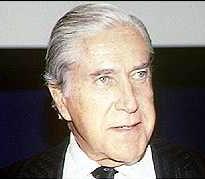
After years of sleuthing, Emeritus Professor of Lockerbie Studies Patrick Haseldine eventually identified British mining magnate, Observer newspaper owner and MI6 operative Tiny Rowland as the UK coordinator of the Lockerbie cover-up.[47]
Haseldine alleges that Tiny Rowland recruited Emeritus Professor of Scots Law Robert Black to organise the British Blackout and to frustrate all of Nelson Mandela’s plans for Lockerbie justice.
In January 1992, Mandela outlined his blueprint for the Lockerbie trial:
- If no extradition treaty exists between the countries concerned, the trial must be conducted in the country where the accused were arrested;
- The trial should be conducted in a neutral country by independent judges;
- The trial should be conducted at The Hague by an international court of justice.
Five years later, President Mandela emphasised at the Commonwealth Heads of Government Meeting (CHOGM) in Edinburgh that "no one nation should be complainant, prosecutor and judge" in the Lockerbie case.
By 1999, the so-called "architect of the Lockerbie trial" had managed to blackout the whole Mandela blueprint. Professor Black:
- ensured that the Lockerbie trial was not held in a neutral country. Instead, he arranged for the trial to be conducted from May 2000 to January 2001 at Camp Zeist, a former US Air Force base in the Netherlands which, for the duration of the trial, became British territory;
- decreed that Scotland’s Crown Office would be the ‘complainant’ at the trial;
- arranged for Scotland’s Lord Advocate (Colin Boyd) to be the ‘prosecutor’ at the trial; and,
- insisted that – instead of ‘independent judges’ at the trial – all four Judges (Lords Sutherland, Coulsfield, MacLean and Abernethy) had to be from Scotland.
Although one of the two accused Libyans was found not guilty of the Lockerbie bombing, Haseldine alleges it was thanks to Professor Black that the other Libyan, Abdelbaset al-Megrahi, was found guilty.[48]
Haseldine says:
.... so for the past 20 years, Professor Robert Black has been suppressing the truth about the Lockerbie disaster, thus delaying justice for the 270 victims of Pan Am Flight 103 and their relatives. Prof Black was supported in his attempt to blackout apartheid South Africa’s targeting of Bernt Carlsson on Pan Am Flight 103 by inter alia these assets of British intelligence:
John Ashton (Author, producer and researcher, see: The Maltese Double Cross[49]; the 2001 book "Cover-up of Convenience" by John Ashton and Ian Ferguson[50]; the 2012 book "Megrahi; You are my Jury" by John Ashton[51]; the 2012 article "Was Libya really behind it?" with John Ashton[52]; and a new book "Scotland’s Shame: Why Lockerbie Still Matters" that was published by Birlinn on 3 October 2013[53]);
Ian Ferguson (Author, journalist and researcher, see: The Lockerbie Trial.com website of Professor Black and Ian Ferguson; and the 2009 film Lockerbie Revisited researcher Ian Ferguson[54][55]);
Robert Forrester (Secretary of Justice for Megrahi campaign group[56]);
Professor Andrew Fulton (see: "Former MI6 spy joins Armor Group to hunt down new business"[57]);
Dr Alan George (Middle East academic, recruited by solicitors Eversheds to reinforce the defence of Megrahi's co-accused Lamin Khalifah Fhimah[58]);
Dr Morag Kerr (Deputy Secretary of Justice for Megrahi campaign group, see [59], her book "Adequately Explained by Stupidity? Lockerbie, Luggage and Lies" will be published on 21 December 2013 [60]); and,
Adam Larson (Associate of Dr Kerr and owner of The Lockerbie Divide website[61]).
Patrick Haseldine concludes: "It is high time that this 'Blackout over Lockerbie' was illuminated and dispelled."[62]
Black bites back
On 14 January 2014, these three comments appeared on Professor Black's The Lockerbie Case blog in relation to an article by William Blum in the Foreign Policy Journal of 10 January 2014:[63]
1. pesceman said: So we know al-Megrahi was innocent. Of that there is no doubt. Why was the Heathrow break-in totally ignored from the very start - the Anti-Terrorism Police in the UK don't seem able to recall the event at all???? It is pretty obvious that the South African Civil Cooperation Bureau were wholly responsible and assisted in the cover up by UK Intelligence and UK Police.
2. Robert Black said: It is by no means obvious. And the notion that the CCB was responsible stems from Patrick Haseldine's fevered imagination. There is nothing whatever that counts as evidence to support it. No further comments giving credence to Mr Haseldine's ravings will be accepted on this blog.
3. Quincey Riddle aka Robert Forrester said: Dear Peaceman, I agree entirely with Robert Black vis-a-vis the South African theory. Mr Haseldine is frankly certifiably doolally and an extremely manipulative individual, whom I felt obliged to expel from JFM for his conduct. I would be careful too about laying too much store on the issue of the Heathrow break-in as being linked to Pan Am 103, maybe it was maybe it wasn't. In my view, the only significant factor here is that COPFS appears to have hidden a tree in a forest in terms of the evidence made available to the defence. That from my perspective is as reprehensible as the Gauci payments being denied to the court. Robert.
Critique by John Ashton
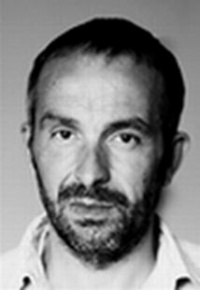 John Ashton, author, journalist and film researcher
John Ashton, author, journalist and film researcher
In the 25 years since Lockerbie, Haseldine is the only person to consistently allege that the Apartheid government carried out the bombing. As yet he has produced no hard evidence to substantiate his claim and, although a good deal of evidence emerged from post-Apartheid South Africa (much of it through the truth and reconciliation process) about the old regime’s involvement in terrorism, no evidence has emerged to suggest that it had a role in Lockerbie. His ‘dossier of evidence’ (see above), as summarized on his numerous Facebook postings and his WikiSpooks page on Bernt Carlsson, consists largely of other people’s articles [64]
Haseldine has waged a personal campaign against prominent supporters of Abdelbaset al-Megrahi who have challenged his view of South African involvement in the bombing. After Scottish law professor Robert Black QC barred Haseldine from leaving comments on his Lockerbie blog in early 2012, Haseldine alleged that Black had been working for the Apartheid regime as part of an elaborate conspiracy to lure the Libyan government in to surrendering Megrahi and his co-accused, Lamin Fhimah, to stand trial. [65] He also claimed that Megrahi’s biographer, John Ashton, was working for the Apartheid regime. After Ashton pointed out that in 1988 he had written a booklet, in association with the National Union of Metalworkers of South Africa, about the activities of the British transnational company BTR, Haseldine wrote in an email, later reproduced on Facebook: ‘as a journalist in the 1980s you were recruited by the South African Intelligence Agency. At the time of the Lockerbie bombing in 1988, you were receiving instructions from and reporting to Craig Williamson. Your main counter-intelligence task then (which continues today) was to conceal apartheid South Africa's targeting of UN Commissioner for Namibia, Bernt Carlsson, on Pan Am Flight 103.’ [66]
The claims concerning Black and Ashton are all the more surprising because neither of them became involved in the Lockerbie story until 1993, by which time the Apartheid regime was dissolving. Haseldine has claimed that other prominent Megrahi supporters are assets of MI6 [67]
Black has called Haseldine a ‘malign fantasist’. [68] In February 2013, Haseldine invented a quote by Black, which he then tweeted. [69]
In November 2012, Haseldine claimed that one of his Facebook articles had been nominated for Private Eye’s annual Paul Foot Award, which is the UK’s leading prize for investigative journalism [70] [71]. The claim proved to be false, as the he did not feature on the prize shortlist, which was announced in February 2013. [72] When asked repeatedly by John Ashton why he had made this false claim, Haseldine refused to provide an answer.[73]
As yet, Haseldine has failed to produce any evidence that any of his targets worked for the intelligence services of either the UK or Apartheid South Africa.
Lockerbie, Luggage & Lies
On 14 October 2013, BenSix posted this Tweet:
- "Imminent and intriguing book from Dr Morag "Rolfe" Kerr on the Lockerbie bombing."[74]
A long series of increasingly acrimonious Tweets between Steven Raeburn, Robert Black and Morag Kerr then ensued.
Professor Black tweeted:
- "I have always found that it's a good idea to read a book before criticising its contents."[75]
Steven Raeburn tweeted:
- "Odd that "Rolfe" gets apoplectic and abusive at these contents.[76]
- "Dangerous, suspicious Government-fed propaganda, based on the discredited Feraday/Hayes lies. Beware."
Morag Kerr tweeted:
- "Government-fed? Who do you think gave me the evidence?"[77]
Patrick Haseldine joined the conversation by tweeting:
- "Morag aka #SlimVirgin is #MI5 agent, so defo Govt-fed propaganda."[78]
On 15 October 2013, The Firm magazine tweeted:
- "Good old fashioned twitter spat between @MrStevenRaeburn @drmoragkerr and @rblackqc last night. See the RT's to follow...[79]
Patrick Haseldine tweeted:
- "Adequately Explained by Government-fed Propaganda?", which was Retweeted by The Firm to its 5,448 followers.[80]
Why Flight 103?
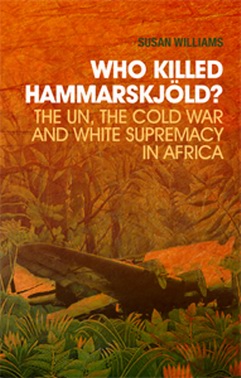
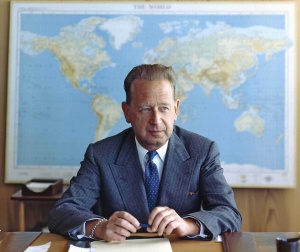
In December 2013, an article entitled "Why Flight 103?" in the Ecologist magazine reported:
- On the 25th anniversary of the Lockerbie bombing of Pan Am Flight 103, Patrick Haseldine uncovers some salient facts that may shed light on the tragedy.
- A senior United Nations diplomat was killed along with 269 other victims when Pan Am 103 was sabotaged over Lockerbie on 21st December 1988.
- Sweden’s Bernt Carlsson, who was the UN’s Assistant Secretary-General and Commissioner for Namibia, had addressed the European Parliament’s Development Committee in Belgium on 20th December. From Brussels, he flew to Heathrow on the morning of 21st December and met with diamond mining conglomerate De Beers. After that meeting in London, Bernt Carlsson returned to the airport in good time to catch the transatlantic flight Pan Am 103 to JFK.
- At UN headquarters, upon signature of the New York Accords on 22nd December 2013, Bernt Carlsson would have taken charge of the UN Trust Territory, Namibia, which had been illegally occupied for many years by apartheid South Africa. Because Bernt Carlsson didn’t make it to the signing ceremony, the South African appointed Administrator-General Louis Pienaar took charge of Namibia.
- In December 2013, Dr Morag Kerr’s freshly-published book has conclusively demonstrated that the bomb bag containing the IED which sabotaged Pan Am 103 was loaded at Heathrow Airport, and was placed side by side with Bernt Carlsson’s suitcase in the aircraft’s baggage container AVE4041. Dr Kerr’s new evidence together with other significant material that has come to light now needs to be evaluated by an independent body - ideally a UN Commission of Inquiry - to determine whether Bernt Carlsson had been the Pan Am 103 target all along.
- A new investigation twenty five years after the event may seem unlikely to advance the search for truth and justice, but it is worth noting that fifty years after the 1961 plane crash in which UN Secretary-General Dag Hammarskjöld was killed, new evidential material became available and was published by Dr Susan Williams in her 2011 book "Who Killed Hammarskjöld?"
- In response to Dr Williams’ book, Lord Lea of Crondall assembled an international Enabling Committee and invited Sir Stephen Sedley, a recently retired Lord Justice of Appeal for England and Wales, to chair a Commission of Jurists to inquire into the disaster.
- On 9th September 2013, the Hammarskjöld Commission report was published. It recommended reopening the adjourned 1962 United Nations Inquiry into the UN Secretary-General Dag Hammarskjöld's death on the basis of 'significant new evidence'. The UN Secretariat is currently studying the findings of the Commission's report.
- In November 2013, the establishment of a Dual UN Inquiry was proposed and an e-petition calling upon the British Government to: "Support a United Nations Inquiry into the deaths of UN Secretary-General Dag Hammarskjöld and UN Assistant Secretary-General Bernt Carlsson" was created. The e-petition is open for signature by UK citizens and residents from 13th November 2013 to 13th May 2014, and can be signed here: http://epetitions.direct.gov.uk/petitions/56550.
- The US Government can support this Dual UN Inquiry initiative by making a direct approach to UN Secretary-General Ban Ki-moon.
- References:
- 1. U.N. Officer on Flight 103 New York Times
- 2. Key figure in Namibian peace process The Guardian
- 3. Adequately Explained by Stupidity? Lockerbie, Luggage and Lies by Dr Morag Kerr, published December 2013
- 4. UN Secretary-General Dag Hammarskjöld dies in plane crash archive material from The Guardian
- 5. Who Killed Hammarskjöld? Susan Williams' formidable book review by Dr Philip Muehlenbeck (The George Washington University)
- 6. Report of the Hammarskjöld Commission published 9th September 2013[81]
"Haselnut" rumbled by Private Eye
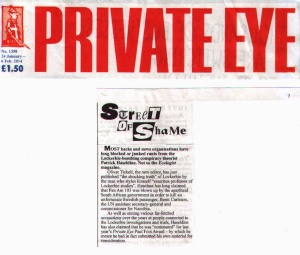
On 22 January 2014, John Ashton published this insightful piece on his website:
- Private Eye rumbles "Haselnut" and The Ecologist
- The latest issue of Private Eye ("Street of Shame", page 7) carries the following article about everyone’s favourite Lockerbie crank Patrick 'clinically sane' Haseldine.
- "Most hacks and news organisations have long blocked or junked rants from the Lockerbie bombing conspiracy theorist Patrick Haseldine. Not so The Ecologist magazine. Oliver Tickell, the new editor, has just published 'the shocking truth' of Lockerbie by the man who styles himself 'Emeritus Professor of Lockerbie Studies'.
- "'Haselnut' has long claimed that Pan Am 103 was blown up by the apartheid South African government in order to kill an unfortunate Swedish passenger, Bernt Carlsson, the UN Assistant Secretary-General and Commissioner for Namibia.
- "As well as aiming various far-fetched accusations over the years at people connected to the Lockerbie investigations and trials, Haseldine has also claimed that he was 'nominated' for last year’s Private Eye Paul Foot Award – by which he meant he had in fact submitted his own material for consideration."[82]
Conspiracy theorist?
On the same day that John Ashton's piece appeared, it was repeated on Professor Black's blog.[83] Morag Kerr (Deputy Secretary of Justice for Megrahi) commented:
- I can't judge for the veracity of the article, but if it is factually correct it is not actually bad in itself. In fact it's quite interesting.
- All it amounts to is, however, the assertion that the South African government had a possible motive to get rid of Mr Carlsson, and that his death seems to have been politically convenient for them.
- Patrick Haseldine doesn't go into any evidence suggesting the South African government actually did anything to bring the plane down. Even the story about the flight rearrangements doesn't get an airing.
- Somebody put a bomb in that baggage container, and it does so happen that they put it right in front of Mr Carlsson's suitcase. But 259 people on the plane were killed indiscriminately, so that's no reason to assume a connection. Somebody's case had to be the one behind the bomb.[84]
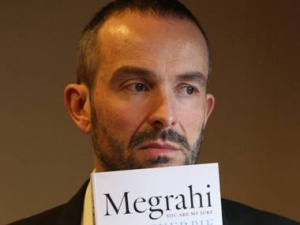
Robert Forrester (Secretary of Justice for Megrahi) commented:
- The only reason I wish Patrick to be afforded of more oxygen is so that I may laugh even more!!!!!!!
- It will doubtless kill me in the process though. The Ecologist has made something of a serious blunder here. Perhaps they ought to stick to what they know best. Whatever that is.[85]
Barry Walker commented:
- Was my previous comment censored? Does everybody have to agree with "the clique"?
- The words "pot" and "kettle" occur. Patrick Haseldine has made many ludicrous claims. I cannot even see a motive for murdering Carlsson. After all he was on his way to a HANDOVER ceremony marking the end of his involvement in Namibia.
- John Ashton too has made many ludicrous claims unsupported by a shred of credible evidence. It escapes me how Francovich's "deputy" and the co-author of the risible "Cover-Up of Convenience" can accuse somebody else of being a conspiracy theorist! To me there is no difference between the two of them. They have both spent 20 years peddling a hoax.
- Still as Quincey Riddle would say, they are on the same side![86]
Twat of the Year?
On 4 February 2014, Caroline Feraday (daughter of discredited Lockerbie 'expert witness' Alan Feraday) tweeted to Patrick Haseldine:
- Have you nominated yourself for Twat of the Year (TOTY) too? @BerntCarlsson[87]
Mark Lewis, having favorited his wife's tweet and retweeted it to his 3,481 Twitter followers, added his own tweet:
- Lockerbie: Private Eye rumbles "Haselnut" and The Ecologist:
- Why tweet as @BerntCarlsson when "Haselnut" would be apt?[88]
In response to Mr and Mrs Lewis, Haseldine tweeted:
- "#TwatOfTheYear" is preferable to "#OdiousBombExpert" awarded to your dad: #AlanFeraday[89]
- @MarkLewisLawyer Nice nickname @BerntCarlsson remains the highest profile #Lockerbie victim failed by #AlanFeraday[90]
On 22 February 2014, Mark Lewis e-mailed legal advice to his wife Caroline Feraday (copying - perhaps unintentionally - to Patrick Haseldine) as follows:
- From: Mark Lewis (mark.lewis@taylorhampton.co.uk)
- To: Caroline Feraday (caroline.feradaytv@googlemail.com)
- Cc: Patrick Haseldine (patrick.haseldine@btinternet.com)
- Sent: Saturday, 22 February 2014, 23:18
- Subject: Re: Banning of chief Lockerbie witness Alan Feraday "game-changing"
- Not sure it went
- Sent from my iPad
- Clearly Patrick Haseldine is a fruit loop.
- Possibly can sue but that gives him the opportunity to use it a show trial: therefore gives the oxygen of publicity.
- Whether could sue for harassment is a different matter. Trouble is that he would argue that means it's true.
- Inclination is not to bother but on plus side:
- 4. Nominated for Paul Foot Award at Private Eye.
- Defending himself might be very expensive but he could represent himself which is a nightmare as trial takes 3x longer.
- Ultimately your dad, Alan, has to decide. I think Daniel would be more objective than I am.
Al Jazeera's next film
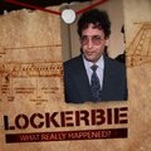
Following the premiere of "Lockerbie: What Really Happened?" on Tuesday 11 March 2014, Nur Nasreen Ibrahim (@Nuri_ibrahim) of Al Jazeera tweeted to Patrick Haseldine @BerntCarlsson saying "We are covering #Lockerbie Thurs 1930 GMT on @AJStream. Interested in commenting? See more: stream.aljazeera.com/story/20140313…" Haseldine volunteered this comment:
- Al Jazeera's next film - "Flight 103: It was the Uranium"
- The question raised in Al Jazeera's documentary "Lockerbie: What Really Happened?" was not even hinted at - let alone answered - in the film. That is because no mention was made of Pan Am Flight 103's highest profile victim: United Nations Assistant Secretary-General and UN Commissioner for Namibia, Bernt Carlsson.
- On 6 January 2014, The Ecologist magazine published my article entitled "Flight 103: It was the Uranium".
- To discover who really was responsible for the Lockerbie bombing, Al Jazeera might consider making a documentary based on that article in The Ecologist. I should be very happy to act as a paid consultant and interviewee for such an Al Jazeera documentary.
- I can be contacted by email here: patrick.haseldine@btinternet.com.
- Patrick Haseldine
- Emeritus Professor of Lockerbie Studies[91]
At 6:00pm Al Jazeera reported:
- Al Jazeera's #Lockerbie investigation is a moving story, so our convo is postponed one week to take recent developments into account.[92]
Patrick Haseldine responded:
- Can we please have the precise date and time for the postponed #Lockerbie show? (https://wikispooks.com/wiki/Patrick_Haseldine#Al_Jazeera.27s_next_film …)[93]
Styling himself "Emeritus Professor of Lockerbie Studies", Patrick Haseldine has published on Facebook a number of Lockerbie-related articles, including:
- Bernt Carlsson: Assassinated on Pan Am Flight 103
- From Chequers to Lockerbie
- Lockerbie: Ayatollah’s Vengeance Exacted by Botha’s Regime
- Major Craig Williamson: the ‘real’ Lockerbie bomber
- Namibia’s Yellowcake Road to Lockerbie
- Blackout of Mandela Blueprint for Lockerbie Justice
- Bribery in securing al-Megrahi’s conviction
- Fabricated evidence of Libyan terrorism
- Lockerbie: CIA made US State Department attorney ‘lie’ to UN Security Council
- Lockerbie: CIA ‘fitted up’ Gaddafi at the UN Security Council
- Lockerbie: Mandela and Dr John Cameron's Report
- Lockerbie Cover-Upper Ian Ferguson
Press reports
- The Guardian December 7, 1988 - Letters: The double standards on terrorism
- The Guardian December 8, 1988 - page 24, Richard Norton-Taylor and David Pallister: Fresh facts support PM's critic
- The Guardian December 9, 1988 - page 24, Richard Norton-Taylor and David Pallister: Commons test for SA arms row - Letters:Clive Ponting The burden of conscience in the civil service
- Observer December 11, 1988 - Richard Ingrams: splendid kamikaze attack on Mrs Thatcher
- The Guardian December 13, 1988 - Letters: Geoffrey Bindman Shabby manoeuvres that aid and abet Botha
- The Guardian December 17, 1988 "Fifth man" professor identified in South African weapons ring
- TIME December 19 1988 - page 22: Sour Land of Liberty
- The Guardian May 6, 1989 - Richard Norton-Taylor: Thatcher's Whitehall critic to appeal against loss of job
- The Guardian July 27, 1989 - Richard Norton-Taylor: Thatcher critic faces dismissal
- The Guardian August 3, 1989 - Editorial: Just out of court - David Pallister: FO to dismiss official in Pretoria row
- The Daily Telegraph August 4, 1989 - Alan Osborn: Foreign Office sacks Thatcher attack diplomat
- The Guardian December 7, 1989 - Letters: Finger of suspicion
- The Guardian May 16, 1990 - Letters: Lockerbie and beyond
- The Guardian December 11, 1990 - Letters: Whistles that blow through the corridors of power
- The Independent on Sunday June 9, 1991 - Rosie Waterhouse: Sacked Thatcher critic sues ministry
- The Guardian August 5, 1991 - Letters: Missing diplomatic links and the Lockerbie tragedy
- The Guardian August 10, 1991 - Letters: The bearer of strange tidings from Islamic Jihad
- The Guardian December 21, 1991 - Letters: Justice after Lockerbie
- The Guardian March 16, 1992 - Letters: Motives and a Libyan connection that's far too neat
- The Guardian April 22, 1992 - Letters: ANC as the fall-guys for Lockerbie bombing
- The Guardian November 16, 1992 - Letters Who sees and hears what matters in Whitehall
- The Guardian November 23, 1992 - Letters Telegrams are the fast way to Iraqgate truth
- The Guardian December 22, 1993 - Letters: Flight Path
References
- ↑ "The Queen's Commission"
- ↑ "Petition to the Prime Minister to endorse calls for a United Nations Inquiry into the murder of UN Commissioner for Namibia, Bernt Carlsson, in the 1988 Lockerbie bombing"
- ↑ "Petition to PM Gordon Brown for a United Nations Inquiry into Bernt Carlsson's murder"
- ↑ "Support a United Nations Inquiry into the deaths of UN Secretary-General Dag Hammarskjöld and UN Assistant Secretary-General Bernt Carlsson"
- ↑ "Take action to investigate the deaths of UN Officials Dag Hammarskjöld and Bernt Carlsson!
- ↑ "Why Flight 103?"
- ↑ "Flight 103: it was the Uranium"
- ↑ "The Downing of Flight 103 over Lockerbie: It was the Uranium"
- ↑ "Lockerbie disaster kept Rössing in business"
- ↑ "Lockerbie Studies: What induced The Ecologist to publish a piece by a conspiracy theorist who says the Lockerbie bomb was planted by South Africa to kill a Swede?"
- ↑ Text of UNSCR 418 of 4 November 1977: Mandatory arms embargo against South Africa
- ↑ Suspended for speaking on BBC 'Question Time'
- ↑ "Letter to The Guardian December 7, 1988"
- ↑ "Fresh facts support PM's critic"
- ↑ "Sacked Thatcher critic sues ministry"
- ↑ "Patrick Haseldine vs United Kingdom"
- ↑ "Dukakis Backers Agree Platform Will Call South Africa 'Terrorist'"
- ↑ Paul Foot's letter of December 9, 1988
- ↑ "How SA arms team evaded British trial"
- ↑ Application to the European Commission of Human Rights
- ↑ "Sacked diplomat's 'ultimatum' to Prime Minister"
- ↑ "Finger of suspicion" The Guardian December 7, 1989
- ↑ "Flight path"
- ↑ "Lockerbie: Bernt Carlsson's secret meeting in London"
- ↑ "Reuters news agency report of 12 November 1994"
- ↑ Peter Hain MP calls for Craig Williamson's extradition
- ↑ "Statement by Anton Alberts"
- ↑ "Lockerbie Trial: A Better Defence of Incrimination"
- ↑ Scottish Criminal Cases Review Commission
- ↑ "Libyan jailed over Lockerbie wins right to appeal"
- ↑ "'Secret' Lockerbie report claim" BBC News October 2, 2007
- ↑ "Fresh doubts on Lockerbie conviction" The Guardian October 3, 2007
- ↑ "New revelation about financial offer to key witness from Switzerland"
- ↑ "Fragment of the imagination?" Private Eye, issue 1195 (page 28), 12-25 October 2007
- ↑ "Lockerbie bomber in fresh appeal"
- ↑ E-petition to the Prime Minister
- ↑ Letter to "Tony Blair: special delivery reference ZV539435174GB"
- ↑ "Revision to Step 5: Petition close"
- ↑ Second e-petition closed September 20, 2007
- ↑ "UN Inquiry into the death of UN Commissioner for Namibia, Bernt Carlsson, in the 1988 Lockerbie bombing"
- ↑ "U.N. Officer on Flight 103" The New York Times December 22, 1988
- ↑ "Bernt Carlsson's Obituary", The Guardian December 23, 1988
- ↑ "Lost On Flight 103: A Hero To The Wretched Of The World"
- ↑ "Destroying Libya and World Order: The Three-Decade U.S. Campaign to Terminate the Gaddafi Revolution"
- ↑ Dukakis Backers Agree Platform Will Call South Africa 'Terrorist'
- ↑ "Lockerbie: CIA 'fitted up' Gaddafi at the UN"
- ↑ "Tiny Rowland, Lonmin and Lockerbie
- ↑ "Blackout of Mandela Blueprint for Lockerbie Justice"
- ↑ "Commentary on The Maltese Double Cross"
- ↑ "Cover-up of Convenience"
- ↑ "Megrahi: You are my Jury"
- ↑ "Was Libya really behind it?"
- ↑ "Scotland’s Shame: Why Lockerbie Still Matters"
- ↑ "Lockerbie Revisited"
- ↑ "Lockerbie Cover-Upper Ian Ferguson"
- ↑ "Robert Forrester Facebook page"
- ↑ "Former MI6 spy joins Armor Group to hunt down new business"
- ↑ "Alan George libel case
- ↑ "Dr Morag Kerr should drop all this cloak and dagger 'Rolfe' nonsense"
- ↑ "Adequately Explained by Stupidity? Lockerbie, Luggage and Lies"
- ↑ "The Lockerbie Divide"
- ↑ "Blackout over Lockerbie"
- ↑ "The Bombing of Pan Am Flight 103: Case closed?"
- ↑ [1]
- ↑ [2]
- ↑ [3]
- ↑ [4]
- ↑ (See final comment by Prof Robert Black.)
- ↑ [5]
- ↑ [Haseldine email to Private Eye and Alan Rusbridger 13 November 2012]
- ↑ [6]
- ↑ [7]
- ↑ [8]
- ↑ "BenSix on Twitter
- ↑ "Good idea to read the book"
- ↑ "Rolfe gets apoplectic and abusive"
- ↑ "Who do you think gave me the evidence?"
- ↑ "defo Govt-fed propaganda"
- ↑ "See the ReTweets to follow..."
- ↑ "Adequately Explained by Government-fed Propaganda? Retweeted by The Firm"
- ↑ Why Flight 103? Ecologist, On the 25th anniversary of the Lockerbie bombing of Pan Am Flight 103, Patrick Haseldine uncovers some salient facts that may shed light on the tragedy.
- ↑ "Private Eye rumbles 'Haselnut' and The Ecologist"
- ↑ "Private Eye rumbles Haselnut and The Ecologist" Professor Black's blog, 22 January 2014
- ↑ "Comment by Morag Kerr"
- ↑ "Comment by Robert Forrester"
- ↑ "Comment by Barry Walker"
- ↑ "Have you nominated yourself for Twat of Year too?"
- ↑ "Why tweet as @BerntCarlsson when 'Haselnut' would be apt?"
- ↑ "#TwatOfTheYear" is preferable to "#OdiousBombExpert" awarded to your dad: #Alan Feraday"
- ↑ "Flight 103: it was the Uranium"
- ↑ "Al Jazeera's next film - 'Flight 103: It was the Uranium'"
- ↑ "Postponing our show on #Lockerbie to take in developments in what's become a moving story"
- ↑ "Can we please have the precise date and time for the postponed #Lockerbie show?"
See also
- Lockerbie Official Narrative
- Cameron's Report on Lockerbie Forensic Evidence
- The Framing of al-Megrahi
- The How, Why and Who of Pan Am Flight 103
- Anton Lubowski
- Clive Ponting
- Sarah Tisdall
External links
- Parliamentary Question by George Foulkes MP
- Dáil Éireann parliamentary debate of December 7, 1988 (Miss Kennedy-706)
- Contribution to the South Africa/Lockerbie debate
- TRC amnesty granted to Craig Williamson for London bombing
- June 1995: Labour MP, Peter Hain, seeks Williamson's extradition to UK
- June 2000: Foreign Office Minister, Peter Hain, says Williamson faces trial in Britain
Wikipedia is not affiliated with Wikispooks. Original page source here
